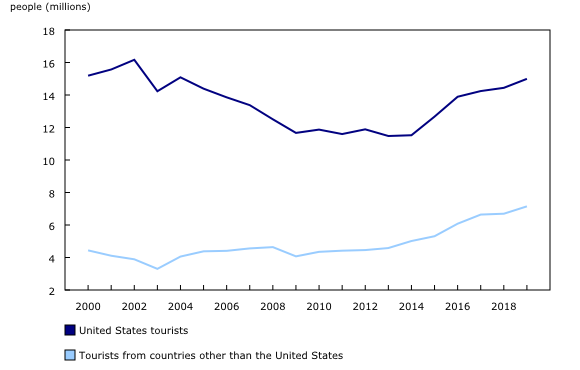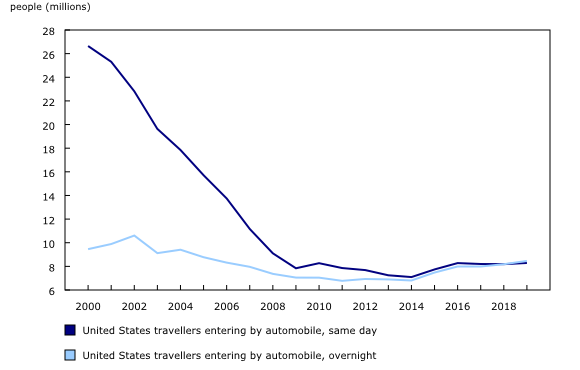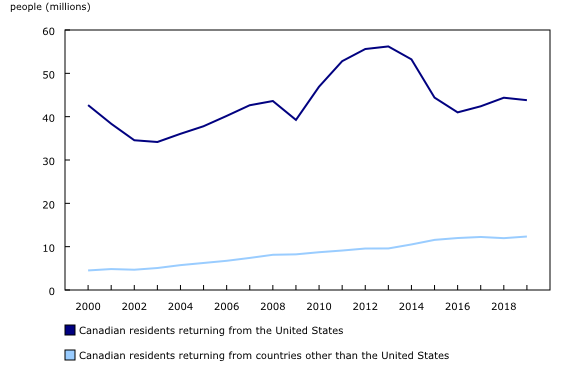Travel between Canada and other countries, December 2019
Archived Content
Information identified as archived is provided for reference, research or recordkeeping purposes. It is not subject to the Government of Canada Web Standards and has not been altered or updated since it was archived. Please "contact us" to request a format other than those available.
Released: 2020-02-21
Year-end review, 2019
Number of tourists to Canada continues upward, surpassing the previous record in 2018
Canada received a record 22.1 million international tourists from abroad in 2019, surpassing the previous year's record of 21.1 million. This marked the sixth consecutive year of increased tourist arrivals to Canada, with growth in tourist arrivals from both the United States and overseas.
Strong economies in the major source countries of travellers to Canada, greater flight capacity and easing visa requirements contributed to increased travel to Canada.
The following analysis focuses on 2019 annual totals for tourists and travellers. International tourists are those who made overnight trips, while travellers include those who made either same-day or overnight visits. The majority of same-day trips involve Canadian or US residents who made trips by car across the Canada–US border.
Tourists
The number of tourists from overseas countries (countries other than the United States) rose to 7.1 million arrivals (+454,000) in 2019, while the number of US tourists to Canada rose to 15.0 million (+554,000).
The summer months—June through September—were the peak months for tourism arrivals from overseas to Canada, representing 51.9% of all arrivals from overseas during 2019. By comparison, the peak months for tourism arrivals from the United States were May to October, with 68.8% of all US tourist arrivals to Canada.
With 679,000 overnight air arrivals to Canada, the United Kingdom remained the largest source country for overseas tourists, but was down 0.8% from 2018. This was the third consecutive year-over-year decline in air arrivals from the United Kingdom since 2016, coinciding with the rise of uncertainty around the United Kingdom's withdrawal from the European Union.
Tourists from France took 589,000 overnight trips to Canada by plane, up 6.8% in 2019. France surpassed China as the second-largest source country for overseas tourists to Canada by air, a position it last held in 2015. More than three-quarters of air arrivals from France landed in Quebec.
Tourist arrivals from China to Canada by air declined 9.6% in 2019 to 571,000 trips. This was the first decline since 2003, the year of the SARS (severe acute respiratory syndrome) outbreak that affected international travel worldwide. British Columbia (279,000) and Ontario (233,000) were the primary provinces of entry for tourist arrivals from China by air.
More US tourist arrivals to Canada in 2019
The number of US tourists to Canada increased 3.8% since 2018, reaching 15.0 million. This was the sixth consecutive year of growth since 2014 and the highest level since 2004. The number of US tourists to Canada remained below the peak of 16.2 million in 2002.
In 2019, tourists from the United States represented over two-thirds of all international tourist arrivals to Canada. This share, however, continued to decline because the number of tourists from overseas countries has grown at a faster pace. Since 2000, the share of tourists coming to Canada from overseas countries has risen from 22.6% to 32.3%, while the share of those from the United States has fallen from 77.4% to 67.7%.
Travellers
Fifth straight year of growth in US travel to Canada
Since 2018, US travel to Canada increased 2.3% to 25.0 million in 2019, the fifth consecutive year of growth in travel from the United States. Same-day and overnight travellers to Canada from the United States made over three-quarters of all trips to Canada by travellers from abroad.
In 2019, the majority of US residents entered Canada by car, up 2.3% since 2018 to 16.7 million. This was the second consecutive increase.
In 2019, overnight arrivals from the United States by car rose 3.4% to 8.5 million, and same-day car arrivals increased 1.2% to 8.3 million. This was the first year since record keeping began in 1972 that US travellers on overnight car trips across the border outnumbered those on same-day car trips.
In 2000, US residents made 26.6 million same-day car trips to Canada, compared with 8.3 million in 2019. As a result, the share of US car arrivals in Canada for same-day car trips fell from 73.8% in 2000 to 49.5% in 2019.
In 2019, 5.6 million travellers from the United States arrived in Canada by plane, up 3.0% from a year earlier. The number of air arrivals from the United States has grown in 9 of the past 10 years since 2010.
In 2019, British Columbia recorded the highest growth, with arrivals at airports by US residents up 4.7%. This was also the seventh consecutive year of growth in air arrivals to British Columbia from the United States since 2013—when the Canadian dollar was last at par with the US dollar.
The number of US travellers to Canada arriving by plane increased from 4.4 million in 2000 to 5.6 million in 2019, while the number of those arriving by car fell from 36.1 million to 16.7 million over the same period.
Fewer travellers to Canada from Europe since global recession in 2008/2009
In 2019, Canada welcomed 7.5 million travellers from overseas countries. Travellers from Europe—the major source region of travellers to Canada—took 3.2 million trips to Canada. Since the global recession of 2008/2009, the share of overseas travellers to Canada from Europe has declined from 54.0% in 2009 to 42.6% in 2019. Growth in the numbers of travellers to Canada from other regions of the world has also contributed to this decline.
Travellers from Asia took 2.5 million trips to Canada in 2019. This accounted for 33.5% of all overseas trips taken by travellers to Canada in 2019, up from 26.0% in 2009.
In 2019, travellers from Oceania including surrounding islands (449,000 trips) and South America (341,000 trips) were the next largest regions of overseas travellers to Canada.
Note that a change in methodology contributed to a significant increase of overseas arrivals by land in 2019.
Fewer Canadians return from the United States by car, but more return by plane
Canadian residents returned from 43.8 million trips to the United States in 2019, down 1.3% from 2018 and well below the peak of 56.2 million trips in 2013, when the Canadian dollar was last at par with the US dollar.
In 2019, about three-quarters of all trips by Canadians to the United States were by car, down 3.0% since 2018 to 32.4 million.
Canadian residents made 21.5 million same-day car trips across the border in 2019, down 4.4% since 2018. This accounted for about two-thirds of all car trips to the United States. Overnight car trips to the United States edged down 0.1% to 10.9 million trips.
In 2019, air travel to the United States by Canadians rose 4.2% to 10.0 million trips. The increase took place mostly in Ontario, where the number of Canadian residents returning from trips to the United States by plane rose 9.3%.
Travel overseas by Canadians reaches new high
Canadian residents made 12.3 million trips overseas (countries other than the United States) in 2019, surpassing the previous record of 12.2 million set in 2017. This was a 3.2% increase from that in 2018, when Canadian travel overseas had declined 2.2%—the first decline in 15 years.
Monthly review, December 2019
More travellers from China to Canada, but fewer from the United Kingdom
Residents of overseas countries made 624,000 trips to Canada in December 2019, up 1.9% from November. Arrivals from the United Kingdom, Canada's largest source of overseas travellers, declined 3.7% in December to 74,000—possibly related to uncertainty around Brexit. In contrast, arrivals from China rose 5.4% in December to 63,000 trips.
Travel from France to Canada declined 2.0% in December to 55,000 trips, since labour actions in France caused delays and cancellations of some transatlantic flights.
More US travellers to Canada
Travellers from the United States took 2.1 million trips to Canada in December, up 2.7% from November and a level last observed for the month of December in 2006. Both plane (+4.7%) and car (+2.6%) arrivals increased. Travellers from the United States took 479,000 trips to Canada by plane and 1.4 million trips by car.
More Canadian residents travel abroad
Canadian residents returned from 4.8 million trips abroad in December, up 2.9% from the previous month.
Of these 4.8 million trips, 3.8 million were to the United States, up 3.3% from November. Almost three-quarters of these trips to the United States were made by car. Same-day car trips across the border edged up 0.4% to 1.8 million in December, while the number of return trips from overnight car trips rose 9.4% to 966,000.
The number of plane trips to the United States rose 1.5% since November to 877,000. This was 4.7% higher than in December of the previous year.
In December, travel to overseas countries by Canadian residents rose 1.8% to 1.1 million trips—the highest level on record for the month of December.
Note to readers
Monthly data are seasonally adjusted. For information on seasonal adjustment, see Seasonally adjusted data – Frequently asked questions. Year-to-date figures are based on unadjusted data.
Seasonally adjusted data from July to November 2019 have been revised. No revisions were made to non-seasonally adjusted data.
Data for Statistics Canada's Frontier Counts program are produced using administrative data received from the Canada Border Services Agency (CBSA) on all international travellers who have been cleared for entry or re-entry into Canada. This includes residents of Canada, the United States and overseas entering Canada from abroad.
Starting with January 2019 data, Statistics Canada updated the method of determining trip durations for US residents travelling to Canada and for Canadian residents returning from the United States. This change affects the relative proportions of same-day and overnight travellers arriving in Canada by air and by "other" modes of transportation (train, marine private, pedestrians, other vehicles). Trip durations for travel by automobile and bus are not affected. Caution is therefore advised when comparing 2019 data with data from earlier periods for these modes of transportation. Users analyzing trends in the same-day or overnight travel portions for these modes of transportation are advised to also compare trends for the total as a reference.
In 2017, CBSA began introducing the electronic Primary Inspection Kiosk (PIK) system at airports in Canada. The PIK system replaces the E311 Declaration Cards that were completed by international travellers to Canada. Data users are cautioned that the switch from E311 cards to PIK has affected the historical comparability of some data series.
Further information on the switch from E311 cards to PIK is available in the document "Impacts on Statistics Canada travel and tourism data resulting from replacement of E311 declaration cards with Primary Inspection Kiosks".
In 2018, Statistics Canada undertook a review of sources of data on overseas residents entering Canada at land ports. Overseas residents who enter Canada at land ports represent about 10% of total overseas travellers to Canada.
Total counts of overseas travellers were revised to reflect new sources of data at some ports. In addition, starting with August 2018 data, Statistics Canada implemented a new method for estimating the country of residence through breakdowns of these overseas travellers when they enter Canada at most land ports.
These changes have varying degrees of impact on the total counts of travellers to Canada from individual countries. Users are therefore advised to use caution when comparing changes in travel to Canada with previous months for individual overseas countries.
Overseas countries refer to countries other than the United States.
A Canadian resident traveller is a Canadian resident who has travelled outside Canada for a period of less than 12 months.
A non-resident traveller is a resident of a country other than Canada who is travelling to Canada for a period of less than 12 months.
An overnight traveller or a tourist is a traveller whose trip includes one or more nights' stay.
Products
The December 2019 issue of International Travel, Advance Information, Vol. 35, no. 12 (66-001-P), is now available.
Contact information
For more information, or to enquire about the concepts, methods or data quality of this release, contact us (toll-free 1-800-263-1136; 514-283-8300; STATCAN.infostats-infostats.STATCAN@canada.ca) or Media Relations (613-951-4636; STATCAN.mediahotline-ligneinfomedias.STATCAN@canada.ca).
- Date modified:





